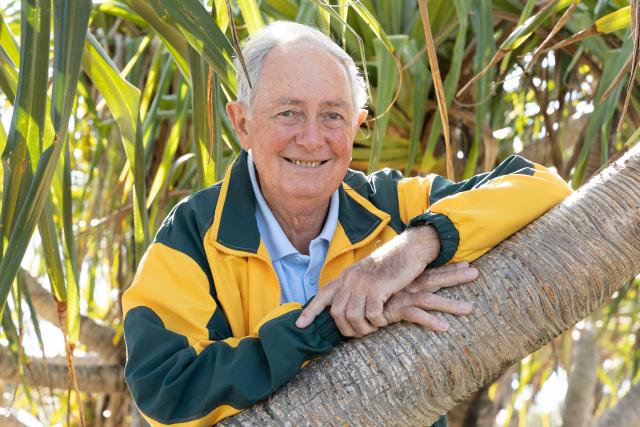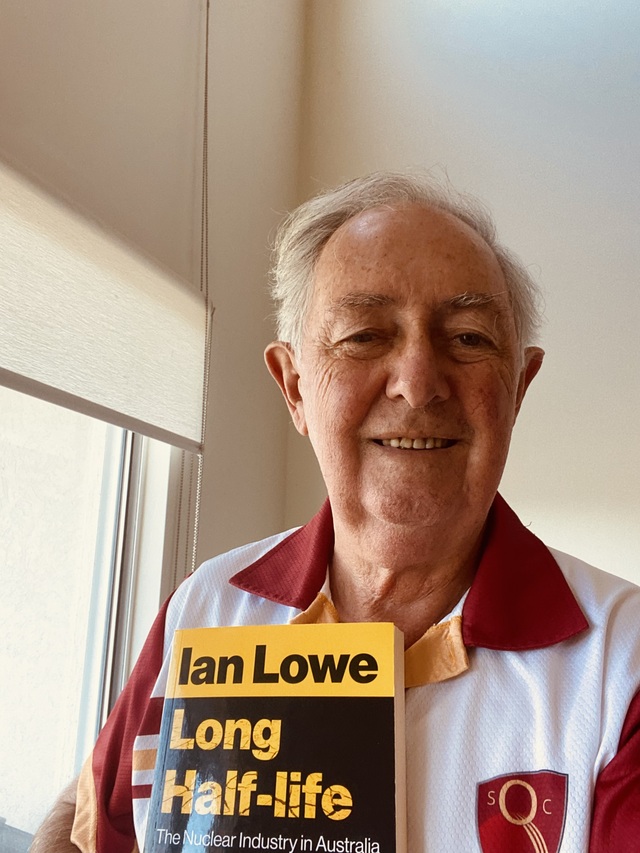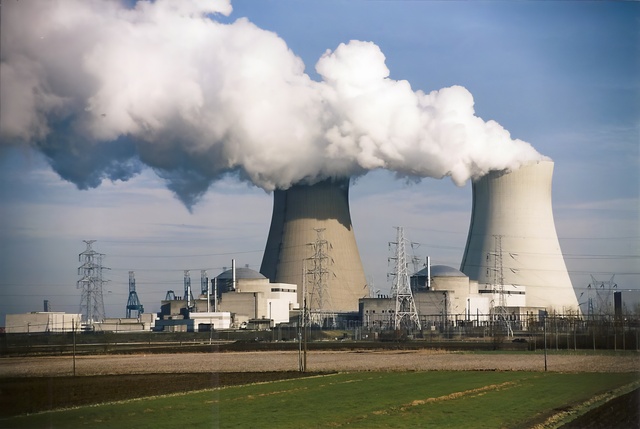Fifty years ago, all the plans for Australia to build nuclear power stations had been scrapped. John Howard tried unsuccessfully to revive the technology, but until recently there was broad agreement that it did not make sense for Australia. More recently, the Dutton Opposition has proposed building nuclear power stations. One of Australia’s most respected environmental scientists, Professor Ian Lowe says, “While many informed observers doubt whether those proposals will eventuate, they would add a whole new dimension to the problem of managing radioactive waste”.
Author of the book “Long Half-Life, The Nuclear Industry in Australia”, Dr Lowe last week spoke on the issues of nuclear power, the Aukus agreement and nuclear waste storage at Noosa Parks Association’s Friday Environment Forum.
In the 1930s the basic physics was done to understand the properties of the atomic nucleus. In the late 1930s two scientists discovered the possibility of chain reaction whereby the fissioning of one atom into particles caused another atom to fission and another atom to fission and so on and suggested to leaders it would be possible to harness that science to create a mega-bomb far more powerful than bombs already doing massive damage. That led to the Manhattan project, the production of atomic bombs, two dropped on cities in Japan leading to the end of WWII.
After the war the US was reluctant to share information on that project with even their closest allies so the UK started producing their own nuclear reactors. As a PR gimmick they discovered the heat produced in the production of plutonium could be used to boil water and generate a modest amount of electricity. Young Queen Elizabeth was persuaded to flick a switch supplying power to about 100 houses and distracting attention from the fact the nuclear reactor was to produce plutonium for the British bomb. In the US under the Eisenhower administration they also recognised you could use nuclear heat to boil water and announced a power for peace program, a program of building nuclear power plants to produce electricity. It was at one time claimed it would produce electricity so cheaply we would not need to meter it, just supply it freely – too cheap to meter was the catch cry. The 1960s saw an example of the political use of nuclear energy. The Labor party in UK under Howard Wilson in 1964 was campaigning in a general election, their rallying call was Britain would be powered in the white heat of technological revolution. It involved phasing out dirty old coal fired power stations and replacing them with nuclear energy. They won the election and started building nuclear power stations at which point the trade unionists from the coal industry asked why they were putting them out of work.
In my personal journey I studied electrical engineering and science in late 1950s-early 1960s and finished up doing honours in physics and went to UK to do a PhD in physics, funded by the atomic energy authority. The jobs in physics dried up in about 1970 so I finished up getting a job at the UK’s Open University.
The 70s energy crisis happened and energy was the flavour of the month. We did a study looking at whether the next generation of power stations in the UK should be coal or nuclear. There were published papers showing nuclear was cheaper than coal fired power. There were also published papers showing coal fired power was cheaper than nuclear. There is no agreed basis of comparison. Nuclear power stations are much more expensive to build than coal fired power but nuclear reactors are cheaper to operate. While one is cheaper to build and more expensive to operate the other is more expensive to build and cheaper to operate so whatever assumptions you make allows you to get whatever answer you want.
In 1977 I was back in Australia. I attended a public meeting in a town hall in Nambour because the report of the Ranger Uranium Environmental Inquiry, the Fox report, was published in 1976 and they gave a qualifying yellow light to the mining and export of uranium. They said if we decided to mine and export it we should recognise nuclear reactors produce nuclear reactive waste that needs to be managed for geological time and fissile material could be used for weapons and we should be aware of that, and that there should be public discussion about whether Australia should mine and export uranium.
Nambour Apex club took that up and convened a public meeting. There were two travelling salesman from the uranium industry, the late Ian Henderson who was president of the Campaign Against Nuclear Power and I was there as a nuclear scientist with no axe to grind. I was alarmed to hear the travelling salesmen lying to the community about the likely expansion of the industry and the management of waste. I was able to demonstrate to the community they were being lied to by reading the UK Atomic Energy house journal which made clear what they were being told was not true. The mining industry told the Ranger inquiry they would start exporting 3000 tons of uranium per year, that would expand to 30,000 tons per year. The Ranger mine recently closed and after 40 years produced a total of 120,000 tons. The critics were right.
Since 1980, back in Australia, I was in a range of advisory bodies, including the National Research Advisory Council, as a member representing the public interest on health and safety and the Radiation Safety Advisory Council and when South Australia held a Royal Commission on nuclear industry I was the token scientist on the advisory panel. As a young scientist where people were regularly killed in coal mines I was quite keen on nuclear power. In the 1970s the studies I did led me to a more qualified position. Since then we’ve had Chernobyl and Fukushima accidents which demonstrate that it’s credible to have serious accidents to render a whole region permanently uninhabitable.
In 2006 when it became a political embarrassment for John Howard that he’d done nothing on climate change he commissioned a review of nuclear energy, the Uranium Mining Processing and Nuclear Energy Review. They toured the world to find out the state of nuclear technology and their report said basically we could build nuclear power stations but we’d require both the carbon price and other forms of government subsidies and it’d take at least 10 years and probably 15 to build one nuclear power station. I published an essay called Reaction Time, Climate Change and the Nuclear Option in which I pointed out if you were serious about climate change, nuclear was not a very good option.
If you look at the history of Australia in the 1950s we exported uranium quite cheerfully to UK and US for the manufacture of nuclear weapons. Menzies allowed the British to test their nuclear weapons in Australia including on Maralinga in South Australia and the reason indigenous communities are so hostile to anything nuclear is that several of them were physically harmed by British bomb tests because they were in harms way when those bombs got let off. In the 1960s there were debates about whether to build nuclear power stations. None of the states decided to, partly because we had separate electricity grids, none large enough for a nuclear power station. Gorton called for tenders to build a nuclear power station at Jervis Bay. When Gorton was toppled, Billy McMahon replaced him and was alarmed that tenders were twice what they were assured it would cost. He put it on pause. The Whitlam government canned it completely. From then on the only discussion was whether we should mine and export uranium. Malcolm Fraser’s counter to concerns in the Ranger report was that the waste solution had been solved. As a young scientist I couldn’t say the Prime Minister was lying to the people. I did say to the Courier Mail this was a remarkably modest announcement for a major scientific breakthrough. The waste problem had not been solved. Nearly 50 years later the waste problem still has not been solved.
The Ranger mine was approved by the Fraser government. Bob Hawke was persuaded to approve uranium mining at Roxsby Downs alongside copper and silver.
The South Australian government in 2015 had a Royal Commission on whether to be more involved in the nuclear industry and concluded being involved in nuclear industry beyond mining and export did not make good economic sense but did suggest there was an economic opportunity to take in radioactive waste. They argued to be safely stored for all time it needed to be in stable geological strata. An expert panel recommended not to go ahead. Mr Dutton raised a few months ago if they were elected they would build nuclear power stations. In 2010 there were legitimate views on realistic and cost effective ways to decarbonise our electricity supply. I and environmental scientist Professor Barry Brook wrote a book on why we should and shouldn’t build nuclear power stations (Why vs Why: Nuclear Power). Barry was skeptical about the possibility of scaling up renewables to meet demands. He was optimistic about a new generation of nuclear power reactors, small reactors that could avoid problems of conventional nuclear power. I was optimistic about improving technology of solar and wind and pessimistic about a new generation of nuclear reactors.
For 50 years I’d heard the promises of a new generation of nuclear reactors being cheaper and cleaner and had been wrong, and couldn’t accept their assurances glibly.
The current cost of new power according to the CSIRO annual (GenCost) report, wind or solar cells with enough storage to be firming capacity $100-130 per megawatt hour, solar thermal is a bit more expensive, caseload gas is quite a lot more expensive, new coal-fired electricity is a lot more expensive,
If you’re going to responsibly build more gas or coal you should try and do something like store carbon dioxide so it’s not released into the atmosphere. If you add carbon capture and storage the cost is out of sight.
Estimates of nuclear from large power stations or small nuclear reactor is way, way more than renewable energy.
Because of rapid change when Barry and I wrote our book average prices were solar 35 cent per kilowatt hour, wind 14, coal 11, gas 8. By 2020 solar was 3.7 cents, wind 4.1, gas 8, coal 11, nuclear 16.
There’s been a dramatic change in the pattern of investment in renewable energy.
2015 was the first year installation of renewables equalled the installation of fossil fuels (coal and gas). By 2020 figures are 190 new renewable, 8 gas and 3 nuclear.
In 2022 it was 295 gigawatts of renewables, this year it’s estimated to be about 400 gigawatts of renewables, 5 per cent nuclear, 10 per cent fossil fuels. So far this year 85 per cent is renewables.
The world’s electricity industry has voted with their chequebooks and they’re building renewables and storage.
Mr Dutton’s announcement was there’d be seven nuclear reactors at five sites, two in Queensland one in Victoria and one in each SA and WA. The Commonwealth would build and operate these reactors. The first ones would be operating by 2035. This would provide cheap, clean, zero emissions base load power.
Fairfax MP Ted O’Brien is local spokesperson for this and keeps using the phrase zero emissions nuclear power. I’ve written him emails pointing out there is no such thing as zero emissions power. It’s true of solar and wind but energy needs to be expended to build the system. In the case of nuclear power we did the study at the energy research group in the Open University in the 1970s and the amount of fossil fuel energy required to build that reactor so it can generate electricity is about what it would produce in 2.5-3 years of operation. It’s lower emissions than coal or gas but it’s not zero emissions. Solar or wind take about 18months to repay the energy debt incurred to build them.
Mr O’Brien also says Australia is the only one of the 20 largest economies that doesn’t operate nuclear power. There are 14 of the 20 largest economies that have nuclear power, six don’t. Germany and Taiwan are closing them down for economic reasons, solar and wind are so cheap.
There are obvious problems with Mr Dutton’s proposal.
It’s illegal. The Howard government 25 years ago legislated the prohibition of nuclear power in Australia. Victoria, NSW and Queensland have also prohibited steps to building it.
Technical – Dutton and O’Brien say we can build seven nuclear reactors by 2037, the first one operating in 2035. The only three nuclear power stations built in Western Europe in countries with a track record of building and operating nuclear power stations have taken 15-20 years and been over budget.
We would struggle to build one in 12 years.
Economic – UK is building a nuclear reactor which is way behind schedule and three times over budget.
Social – will the community accept having nuclear reactors. Before the election Crisafulli said if elected they wouldn’t let a nuclear power stations be built in the state.
Finally – effectiveness. If do build seven nuclear reactors by 2037 they will provide 5-10 per cent projected to be the electricity demand, where would the rest of it come from.
Would waste be managed responsibly?
How would our neighbours react?
What would the Indonesians think are our motives, in a country with endless solar and wind, the best deposits of fossil fuels, wasting huge amounts of public money to build nuclear reactors. I suspect they would think we were really more intent on nuclear weapons than nuclear power.
I think it’s a distraction. It’s no longer feasible to go to an election without having a plan on climate change. They think if they build nuclear reactors you wan’t notice it’ll take 25 years of burning coal and gas to build them. I think the real agenda is to keep building coal.
Aukus agreement.
I was involved in a seminar in Canberra four years ago on whether our next submarines would be diesel or nuclear. There was significant disagreement in the defence community. The fact nuclear could operate for longer and further away from shore was an advantage, others recognised nuclear submarines can’t operate in the shallow waters around our northern coastline and would be more expensive to operate so there was clear division in the defence community.
The Turnbull government did a deal with France to repurpose their nuclear submarines to conventionally powered submarines. After Morrison toppled Turnbull he started secretly negotiating with the British and Americans for the Aukus agreement under which we would be given some second hand nuclear submarines by US and then cooperate with UK to build a new generation of nuclear submarines with an eye-watering budget, estimated around $368 billion. The other problem with nuclear submarines, the expert who wrote the Defence White Paper in 2009 pointed out, they’re not very effective at defending us as they can’t operate in shallow waters.
What they really do is assist US to confront China in South China Sea. I heard a defence expert say the reason we need submarines is to protect our shipping routes. When asked who were we protecting them from he said, China, of course. Who are we exporting material to? China.
Radioactive waste is an inevitable consequence of radiative technology. The Lucas Heights nuclear reactor is now mainly used to produce radio-isotopes used in medical imaging, treatment of some cancers, industrial uses. There’s about 5000cubic metres of accumulated low level waste with about 40cu metres produced each year. The Commonwealth has made attempts to establish a centralised repository or waste dump to story low level uranium, at Woomera in SA and in the Northern Territory and in every case the project has been stalled, largely by opposition of indigenous community who don’t want waste on their land. There is one repository in WA, company called Tellus Holdings operate a radioactive waste repository. Low level waste is relatively benign. If it’s under a couple of metres of earth the radiation at ground level is not measurably above the background radiation we’re exposed to from metals under our feet, cosmic rays.
Intermediate level waste – from the reactor at Lucas Heights fuel was sent to France for reprocessing, what returned was intermediate level waste. It needs to stored for about 1000 years. At the moment it’s in temporary restorage in Lucas Heights. The temporary storage is enough for about another 5-10 years but there is no long term plan and no permanent solution of what to do with intermediate level waste.
If we were to build nuclear power stations that would produce much more intractable waste, that would need permanent isolation for geological time – 10s of thousands of years. The traditional government approach would be to decide on a site and defend it against local opposition. The US or UK haven’t found a site yet. The only country to take a responsible approach has been Finland. They have local agreement to establish a local repository deep underground under a layer of rock salt. The community return for taking responsibility is local investment. We have proved incapable of managing low level waste.
If we built nuclear submarines they use weapons grade uranium, neither US or UK has worked out what to do with nuclear reactor waste.
We have agreed if they give us nuclear submarines we will look after nuclear waste after their lifespan so we have agreed to solve their problem that neither US or UK has been able over 50 years to solve.
There should be much more discussion on whether we want to take on solving the problem of nuclear waste.









